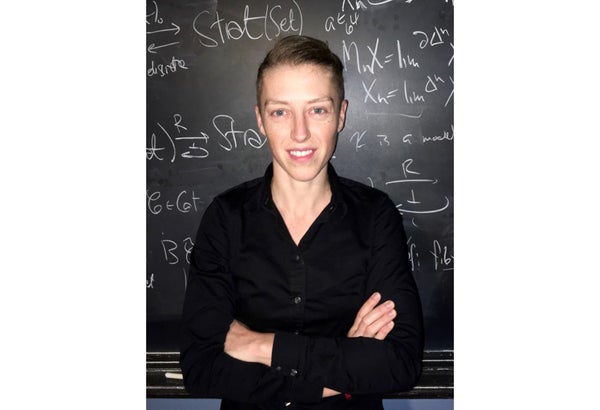This article was published in Scientific American’s former blog network and reflects the views of the author, not necessarily those of Scientific American
In today’s episode of our podcast My Favorite Theorem, my cohost Kevin Knudson and I were happy to welcome Emily Riehl to the show. She’s a mathematician at Johns Hopkins University, and like our previous guest John Urschel, she’s also a football player. (She plays Australian rules football, which we attempted to describe for Urschel in the last episode, and has competed for the US National team.) You can listen to the episode here or at kpknudson.com, where there is also a transcript.
Dr. Riehl studies category theory, an area of mathematics I struggled to describe succinctly for this post. Then I remembered she has literally written the book(s) on it, so why try to reinvent the wheel? Instead I’ll borrow some of her words. In the preface to her book Category Theory in Context, she writes that “the purview of category theory is mathematical analogy. Category theory provides a cross-disciplinary language for mathematics designed to delineate general phenomena, which enables the transfer of ideas from one area of study to another.” A problem that seems difficult in one domain can end up being more tractable in another if you find the right translation between them.
On supporting science journalism
If you're enjoying this article, consider supporting our award-winning journalism by subscribing. By purchasing a subscription you are helping to ensure the future of impactful stories about the discoveries and ideas shaping our world today.
Dr. Riehl’s real favorite theorem is the Yoneda lemma, but she wanted to talk about a different theorem for the podcast. If you’d like to learn more about the real favorite theorem of every category theorist, check out Tai-Danae Bradley’s series about the Yoneda lemma on her blog Math3ma, starting with this post.
The theorem Dr. Riehl chose for the podcast is the theorem that right adjoints preserve limits. Because it is a theorem in category theory, it is stated in a very general and abstract way, but she also showed how to apply it to a more concrete example, the distributive property of multiplication and addition. That is, a(b+c)=ab+ac.
As I admit in the podcast, I feel a little intimidated by category theory, but I appreciated Dr. Riehl’s response: “It’s a language that some people have learned to speak and some people are not acquainted with yet, and that’s totally fine.” We do throw around some technical vocabulary in the episode, so I’ve collected some references here in the show notes so you can explore more deeply at your leisure.
Tai-Danae Bradley’s series on limits and co-limits
The Wikipedia page on adjoint functors and Daniel Kan’s 1958 paper introducing the notion of adjoint functor (pdf)
An expository note for undergraduate math majors by Dr. Riehl on building topological spaces from other spaces (pdf)
In each episode of the podcast, we ask our guest to pair their theorem with food, beverage, art, music, or some other delight in life. Like me, Dr. Riehl is a violist, and we just barely missed meeting each other in Chicago through music. She chose a musical pairing, the Sentimental Sarabande from Benjamin Britten’s Simple Symphony. You’ll have to listen to the episode to learn why she thinks it’s the perfect pairing for right adjoints and their preserved limits. You can listen to the full Simple Symphony here.
You can find Dr. Riehl at her website and on Twitter. Her books Categorical Homotopy Theory and Category Theory in Context have websites too. Through agreements with her publishers, both books are available as PDFs for free. You can find more information about the mathematicians and theorems featured in this podcast, along with other delightful mathematical treats, at kpknudson.com and here at Roots of Unity. A transcript is available here. You can subscribe to and review the podcast on iTunes and other podcast delivery systems. We love to hear from our listeners, so please drop us a line at myfavoritetheorem@gmail.com. Kevin Knudson’s handle on Twitter is @niveknosdunk, and mine is @evelynjlamb. The show itself also has a Twitter feed: @myfavethm and a Facebook page. Join us next time to learn another fascinating piece of mathematics.
Previously on My Favorite Theorem:
Episode 0: Your hosts' favorite theorems Episode 1: Amie Wilkinson’s favorite theorem Episode 2: Dave Richeson's favorite theorem Episode 3: Emille Davie Lawrence's favorite theorem Episode 4: Jordan Ellenberg's favorite theorem Episode 5: Dusa McDuff's favorite theorem Episode 6: Eriko Hironaka's favorite theorem Episode 7: Henry Fowler's favorite theorem Episode 8: Justin Curry's favorite theorem Episode 9: Ami Radunskaya's favorite theorem Episode 10: Mohamed Omar's favorite theorem Episode 11: Jeanne Clelland's favorite theorem Episode 12: Candice Price's favorite theorem Episode 13: Patrick Honner's favorite theorem Episode 14: Laura Taalman's favorite theorem Episode 15: Federico Ardila's favorite theorem Episode 16: Jayadev Athreya's favorite theorem Episode 17: Nalini Joshi's favorite theorem Episode 18: John Urschel's favorite theorem
